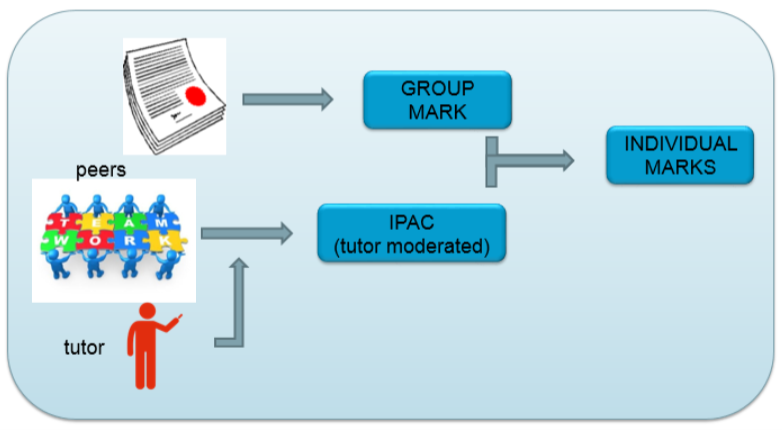IPAC assessment methodology
The IPAC assessment methodology explained
In its more basic form, the IPAC assessment methodology works as follows, depicted in the figure below.
- The group of students complete the project, submit the output (whatever this is) as normal and this is assessed typically by the tutor generating a “group mark”.
- After the students submit their group assignment, they give anonymous scores and anonymous feedback to each other based on their level of contribution and professional conduct during the project. These scores are used to calculate the IPAC scores per individual, that gets moderated or corroborated by the tutors.
- These two marks will then be combined to give each student their own grade, reflecting not only the final piece of assessed work but also how she or he functioned in the group over the whole project

The IPAC scores are typically obtained at the end of the project, after the students submitted the final deliverable. In addition, the IPAC assessment methodology can be used at other key points during the project, even if it is just for formative assessment or to inform the tutor of how the class is doing. For example:
- IPAC can be used at the initial stage of the project so the tutors can see if there are any students that are not engaged or teams with poor group dynamic. This allows the tutor to identify and address any issues before they become more problematic, e.g. talk to certain students, or modify certain groups.
- IPAC can also be used after submission of interim assignments related to the project, particularly in long projects, such that we keep monitoring student engagement and allow students to address any criticisms and improve the way they work within the team.
The concept of the IPAC assessment methodology is simple. However, there are numerous ways in which it can be applied in the classrooms, and many parameters/choices that need to be chosen before it is used. The paper below presents the key points to consider and recommendations for best practice, and it is a recommended read particularly to those new to the IPAC methodology.
- Garcia-Souto, M. P., Azma, Y., Grammenos, R., Kador, T., Striolo, C., Whyndham, M., . . . Hughes, G. (2019). Individual peer assessment of contribution to group work (IPAC): Key points and recommendations. SEFI 47th Annual Conference: Varietas Delectat... Complexity is the New Normality, Proceedings, 1553-1565. SEFI.
Some people might feel nervous or wonder how the IPAC scores will impact the marks of their students. The paper below shows the results obtained from several case studies with classrooms of different sizes (from 13 to 700 students) as well as statistical results found in the literature. The conclusion is that it is safe to use the IPAC assessment methodology.
- Garcia-Souto, M. D. P. (2020). Is it safe to use peer assessment of individual contribution level when assessing group work?. EDULEARN19 Proceedings. IATED. doi:10.21125/edulearn.2019.1842.
Benefits of the IPAC Assessment Methodology
There is a range of benefits to using the IPAC assessment methodology, as listed below. The two most common reasons that drive the staff to use the IPAC assessment methodology are giving fairer marks to each student and promoting student engagement. However, when the IPAC methodology can be run easily like with the UCL IPAC system, there is a range of other benefits that can be exploited. One of such benefits is allowing for self-assessment, and consequently reflection, which will benefit the student. Students will also receive meaningful and individual feedback from the scores and comments given by their peers. Students should be encouraged to write these comments in a constructive and professional way. If students do so, we have found through our research that students will reflect and improve upon the points raised. As the tutor, you will also gain a better understanding of the group dynamics within the team.
In summary, the most important benefits of the IPAC are:
- Fairer marks for individuals
- Encourages students’ engagement and professional behaviour during group work
- Encourages self-reflection
- Welcomed by students, leading to less complaints to tutors and less stress
- Students practice giving constructive and professional feedback
- Insightful feedback: Students learn how their contribution is perceived within the group, and can improve accordingly
- Tutors get a better understanding of the group dynamics at their convenience, e.g. start, during and/or end of the project